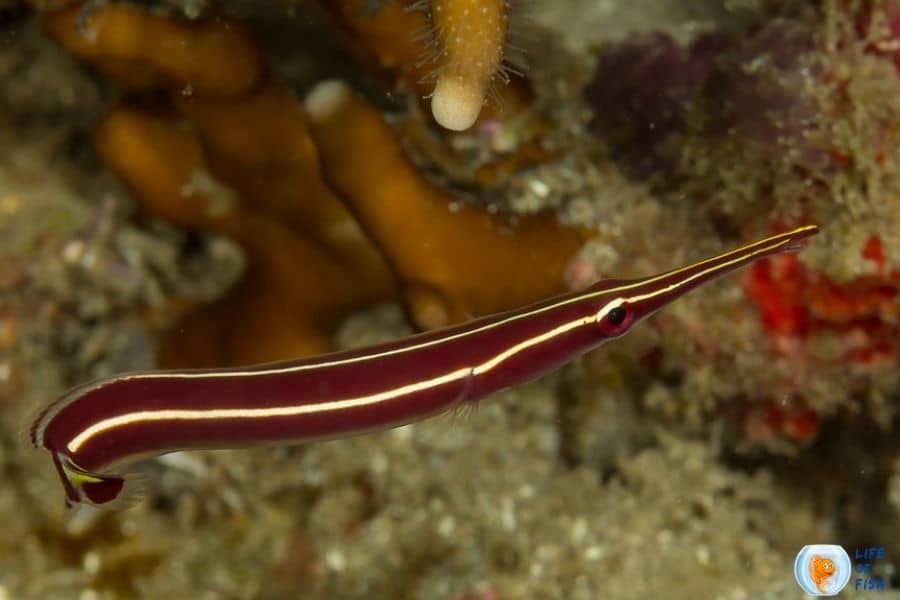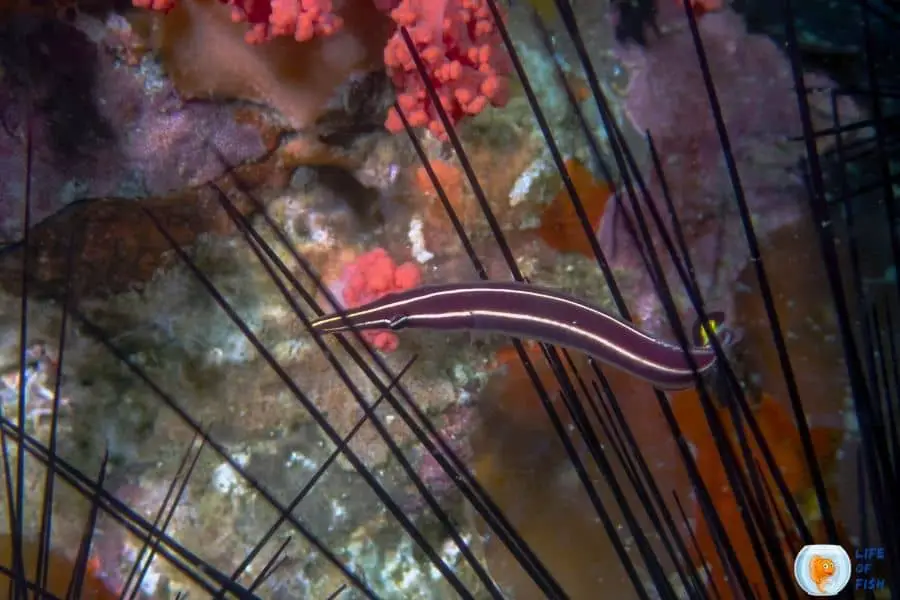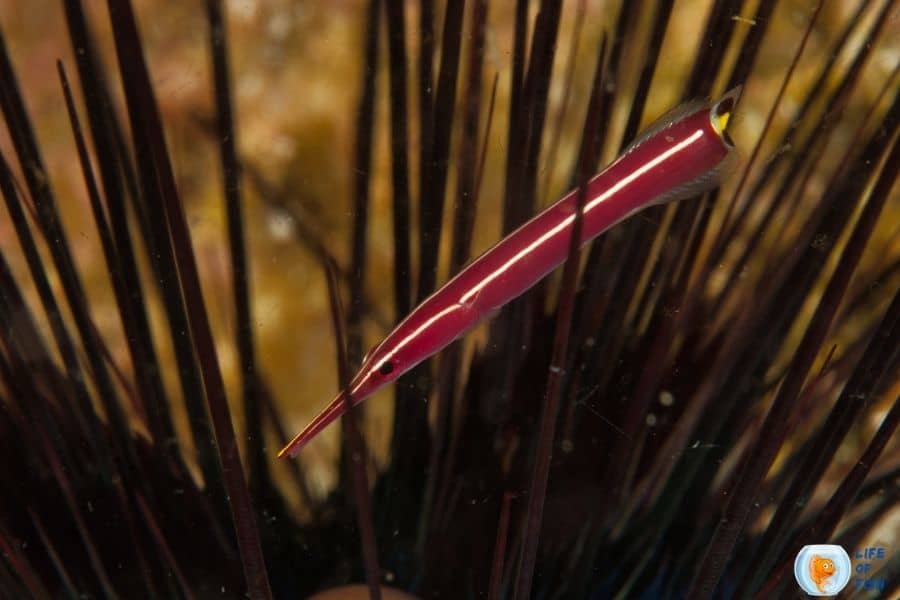Yellow stripe clingfish is a small, yet beautiful marine fish that is mostly found in the Indo-West Pacific region.
They are reef-associated fish and are highly spread near the reefs of Indonesia, Western Australia, Ningaloo, Queensland’s Great Barrier Reef, and the Timor Sea.
Mostly, you can find them on the spines of sea urchins and branching corals. As they are commonly found near sea urchins, they are also called Urchin clingfish.
Although they are a popular variety in the marine aquaculture trade, only experienced aquaculturists can keep them because you need to pay high attention to this species.
As the name suggests, this beautiful creature has narrow yellow to white stripes all over its dark reddish-brown slender body.

They have snuot-like mouths and sometimes it makes them resemble a small seahorse. The tail of this fish is round in shape and features a yellow spot within the center.
They have modified pelvic fins which allow them to cling to surfaces. It is nice scenery to see them dancing and wiggling their slender body around the female during mating.
The yellow strip clingfish are known as Diademichthys lineatus scientifically. They belong to the clingfish family which is named Gobiesocidae.
They don’t have scales like most other fish. Therefore, they release a peptide-like toxin called grammistin on their skin in the form of mucus. This will protect them from external obstacles.
Some aquarists claim that they are symbiotic with Diadema urchins. The real relationship between them is still not proven scientifically.
However, many people in trade advise keeping the yellow stripe clingfish with urchins They are listed as the Least Concern species on the IUCN list.
How big do Yellow stripe clingfish get?
Jump To
- 1 How big do Yellow stripe clingfish get?
- 2 Is Yellow stripe clingfish aggressive?
- 3 Yellow stripe clingfish behavior
- 4 How long do Yellow stripe clingfish live?
- 5 Yellow stripe clingfish care
- 6 Yellow stripe clingfish breeding
- 7 Special tips
- 8 Feeding behavior of Yellow stripe clingfish
- 9 What fish can live with Yellow stripe clingfish?
- 10 Related questions
They are a small fish species and grow only 1.5-2 inches(3.8-8 cm) only.
Is Yellow stripe clingfish aggressive?
They are semi-aggressive species for hermit crabs, other small gobies, and other smaller fish species than them.
Yellow stripe clingfish behavior
They live as a group. Usually, there are three to four members in one school. In such a school, the dominant is a male and the other members are female.
They are mostly found in tropical water and near reef environments naturally and they get the protection of coral branchings and rocks from their predators. Yellow stripe clingfish are diurnal animals and they sleep at night.
They communicate with each other by performing dances and wiggling around the other member and they do this dancing during their mating season too. They are fast swimmers.
How long do Yellow stripe clingfish live?
The life expectancy of these fish is unknown.
One look Care guide
| Scientific name | Diademichthys lineatus |
| Common name | Yellow stripe clingfish, Urchin clingfish |
| Care level | Difficult |
| Native to | Indo Pacific region |
| Type | Tropical marine fish |
| Color | Dark brown body with yellow stripes |
| Tank size | 10 gal for one specimen |
| Preferred temperature | 75 F (24 C) |
| Other water parameters | pH : 8.1 to 8.4 Hardness:8-12 dKH Specific gravity:1.020-1.025 |
| Size | 2 -5 inches |
| Growth rate | Rapid |
| Temperament | Semi-aggressive |
| Recommended tank mates | Nearly any saltwater fish Avoid large carnivore fish(eels, anglers) Snakes and smaller fish species |
| Preferred food | Finely chopped fresh or frozen marine fish Squid Mysis shrimp Vitamin-enriched brine shrimp Frozen carnivore preparations |
| Feeding frequency | Two to three times a day |
| breeding | Egg laying species. Can be bred in captivity |

Yellow stripe clingfish care
Yellow stripe clingfish size
They are not big animals and only reach to 1.5-2 (3.8-8 cm) inches in length.
Yellow stripe clingfish tank size
Since they are small fish they need small space and 10+ gallons is enough for one specimen. However, if you are planning for a group, increase the tank size as in small spaces they can be aggressive.
How many Yellow stripe clingfish should be kept together?
Usually, they behave like a group and you can put 3-4 yellow strip clingfish together. However, make sure there is only one male clingfish and the rest of the group are females.
Tank setup
They are reef-compatible species. They live in close association with long spine urchins or branching corals.
Therefore, provide them with live rocks for hiding places. It is good if you can provide long spin urchins to their aquarium because this helps to mimic their natural environment which makes them be happy.
Some aquarists claim the spine urchins are a must for the aquarium of yellow stripe clingfish.
They also like to cling to empty bivalves or other shells and you can add such things as decorations.
However, they are aggressive with other benthic creatures such as hermit crabs and small gobies. Therefore, take necessary precautions if you are planning to keep them in one tank.
Aquarists, suppose to put live phytoplankton in the aquarium of yellow strip clingfish.
Provide them with fluorescent light. Since they are not trying to jump away from the aquarium, no roof is needed.
They are small fish and can trap in the water pumps, filters, and other equipment. Take necessary precautions to avoid traps in those items.
Water quality condition
Their natural environment is a tropical environment where there is warm water. They need 75 F (24 C) water to thrive in your aquarium.
If your aquarium is in a cold place/country, take the help of a water heater to keep the water temperature constant. The pH value should be in the range of 8.1 to 8.4.
The specific gravity of the water of the aquarium should be in the range of 1.020-1.025 while the hardness should be in the range of 8-12 dKH.The yellow stripe clingfish are sensitive to water conditions. Therefore, keep the water parameters at the recommended range.
Filtration is important to keep the ammonia and organic content of the water in the recommended range. Use an appropriate filter that has no spaces for these fish to be stuck.
Yellow stripe clingfish breeding
Yellow stripe clingfish male or female identification
The Yellow stripe clingfish show sexual dimorphism. The female and male can be identified easily by observing the shape of their mouth. The females of this species have long and narrow snout-like mouths while the males have round snouts.
There is an interesting factor behind the different shapes of their mouths. The male and female yellow stripe clingfish feed on different meals!!
The female clingfish feeds on bivalves in corals and eggs of shrimp. The male feeds on the tube feet of the host. This is the major cause of their sexual dimorphism.
Yellow stripe clingfish breeding
Usually, their reproduction takes place during the warm season and under tropical water.
The yellow stripe clingfish are polygamous by nature which means they have more than one mate.
They form a group of 3-4 members with one male and two to three females. They show beautiful courtship behavior during their breeding time to attract females.
The males wiggle around the females while changing their color. They can change the color of their stripe from yellow to red.
During their dance, the male touches the abdomen of the female and if she is ready to mate. Then the male gets parallel to the body of the female.
The female lay around 5-30 eggs in small clutches. In their natural environment, they spawn in empty clamshells.
There are some cases reported for bred in captivity. You can include empty clamshells or PVC caves in the aquarium if you are going to spawn them.
Firstly, they choose a place for their nest. The nests are guarded and tended by the male, and all the females spawn with the male in the same location.
Their eggs are black in color and you need to closely look if you have inserted a black surface for their nest.
The time taken to lay eggs depends on the female and it can range from a few hours to a day. The male clingfish guard the eggs until they hatch.
If you are going to breed them, make sure there will be only one male because the other males may eat the eggs.
Actually, the parent male eats 30% of the eggs itself and if there are other males you don’t get any eggs !!
The collected larvae should transport to a separate tank. You can feed larvae with rotifers and Apocyclops panamensis copepods.
Further, nannochloropsis, tetraselmis, Isochrysisone, and chaetoceros can be used for green water. The recommended water change is about two water changes of about 2 gallons.
The larvae can be seen clearly as they have patches of dark pigmentation on their bodies. They are about 3mm at hatch.
Yellow stripe clingfish fry care
It is good to transfer the fry to another tank. The best food for the fry are rotifers and Apocyclops panamensis copepods.
Juveniles eat the tiny appendages on the surface of their host sea urchin (pedilillariae, sphaeridia) as their male adults do.

Special tips
The Yellow stripe clingfish have really small mouths. Therefore, you have to be very careful when you going to pick food for them.
Choose small size foods which fit their mouths. They can adjust well to new foods. But in the beginning, it is not easy to make them eat food.
It is good if you can first feed them with live foods. Then you can slowly move to the other commercial foods.
Make sure all the Yellow stripe clingfish in your tank feed properly because some are reluctant to eat foods you feed.
Feeding behavior of Yellow stripe clingfish
What do they eat?
They are carnivores. In the wild, they feed on brine shrimp, their eggs, squid, and small invertebrates.
Females feed on bivalves in corals and eggs of shrimp whereas the males feed on the tube feet of the host.
The females of yellow stripe clingfish help to keep the health of corals as they
prey upon parasitic bivalves that attack various species of corals.
In captivity, they can be trained to eat commercial foods such as finely chopped fresh or frozen marine fish, squid, mysid shrimp, vitamin-enriched brine shrimp, and frozen carnivore preparations. However, feed them meaty food.
Many aquarists claim that they are very picky when they are in captivity. Some reported that their yellow stripe clingfish died due to starvation as they did not get any food after they have been introduced to the aquarium.
Female clingfish somehow learn to grab food from the water column, but at first, they often missed more than they got.
The male yellow stripe clingfish are hard to feed than females. Therefore, aquarists advice to have only female yellow stripe clingfish if you are not very experienced with them.
Male clingfish are known as partial filial cannibalistic animals. They eat some of the eggs from their own clutch and scientists claim it is close to 30% of the eggs.
However, they guard the nest against the other males. This is why the female ratio is higher than the male ratio in the wild.
Fewer males in the wild increase the survival rate of the offspring. They eat eggs in order to keep their body condition well for the next breeding cycle.
How often should you feed
You should feed them two to three times per day
When should you feed (time of the day)
They are diurnal and sleep at night. Therefore, it is good to feed them during the daytime
How long they can go without food
They cant go long without food
What fish can live with Yellow stripe clingfish?
They are not aggressive toward many species of other fish. You can include nearly any type of fish other than large carnivores and snakes as they may prey on the clingfish.
Don’t include small crabs in their aquarium as they may pray on crabs. They are semi-aggressive on the smaller or same size fish such as other goby species and make sure not to include such fish in your aquarium.

Related questions
Is Yellow stripe clingfish aggressive?
They are semi-aggressive species. But they can live peacefully with many species of fish.
Can Yellow stripe clingfish live in a pond?
Yes. they may thrive in ponds too.
Read Next : Flagtail Catfish Care | A Peaceful And Small Catfish |
